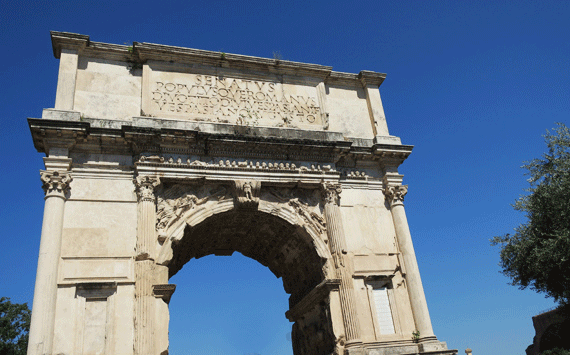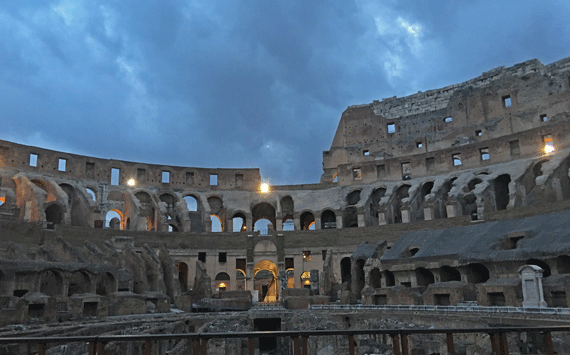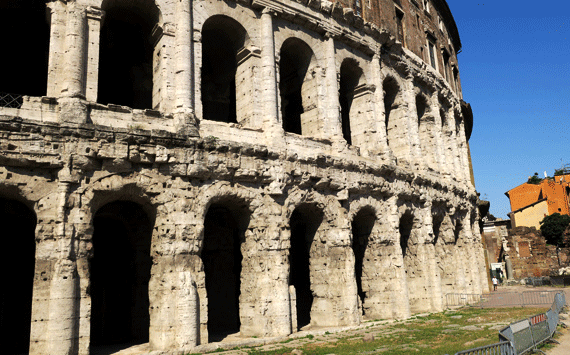| |
|
 |
|
| As a
direct descendant of the Judean nation whose utter
defeat is celebrated here by this arch, the Arch of
Titus, if I were a spitting person, then I would
spit right here! Especially if Titus' ashes had been
buried here in an urn as has been suggested by
scholars. |
|
|
 |
|
Photo:
Gila Yudkin |
|
The Arch of Titus in Rome
celebrates the Roman defeat of Judea |
|
| Our holy
temple in Jerusalem was burned to the ground by
Titus' troops under Titus direction. The holy
vessels including the gold menorah were plundered
and brought to Rome to be exhibited in Vespasian's
trophy museum, the Templum Pacis. |
|
 |
|
Illustration of Roman soldiers looting the Jerusalem Temple exhibited in the summer 2017 exhibition on the
Menorah in Rome's Great Synagogue |
|
|
 |
|
Photo:
Gila Yudkin |
|
Ruins of Vespasian's war trophy
museum, the Templum Pacis (Temple of Peace) |
|
| The
Temple had been renovated about 20 BC by Herod, a
Jewish king whose patrons were first Marc Antony and
then Augustus. It stood to the equivalent of
16 stories, made of gleaming imported white marble.
topped with gold spikes to keep the pigeons from
littering the marble. Eye witnesses, the
rabbis who admittedly were prejudiced, used to
proclaim "ten measures of beauty descended upon the
world, Jerusalem took nine of them, all the rest of
the world one." (Kiddushim 49b)
All because of the glorious Temple. |
|
|
 |
|
Photo:
Gila Yudkin |
|
Model of the Jerusalem Temple,
conquered, burned and destroyed by the Romans |
|
| Hundreds
of thousands of pilgrims would flock to Jerusalem.
The temple was a magnet for Jews around the Roman
Empire, especially the eastern part: Asia Minor,
Alexandria, Antioch, Judea, Parthia. Jerusalem
was an international city despite its distance from
the sea and its isolation from mainland routes.
Jerusalem's greatness was derived from the religious
fervor of millions of Jews living throughout much of
the eastern part of the Roman empire and beyond. |
|
| So how
was the Jerusalem Temple financed? |
|
| By the
religious enthusiasm of Jews from around the Roman
Empire. They contributed half a shekel each
year for the Temple's upkeep. The Tyrean
silver shekel was equivalent to the US dollar
standard used today for world commerce. (The
silver wasn't diluted.) Perhaps the Roman
equivalent was two drachmas. The most
important point was that It was all VOLUNTARY.
And with perhaps a little peer pressure…. |
|
| Even
Jesus, a Galilean who was a Jew gave voluntarily to
the Temple. When the tax collectors arrived to
Jesus' headquarters by the Sea of Galilee
(Capernaum) they asked Peter (Matthew 17:34+)
whether his teacher paid the half shekel tax to the
temple. (Thus is written in Exodus 30:13
"This is what everyone who is numbered shall give:
half a shekel according to the shekel of the
sanctuary half a shekel as a contribution to the
LORD.") |
|
| Peter
asked Jesus whether they should pay and Jesus told
him so as not to cause offense to go to the shore of
the lake, cast his line and lo and behold Peter
caught a fish with a shekel in its mouth. |
|
| The
whole point is that the Jerusalem Temple tax was
voluntary, paid from the heart. And how was all this
Roman imperial building financed? By
confiscation of property, plunder, looting and
robbery after murdering, here in Rome and in the
provinces. And by the way, the riches and
wealth plundered from the province of Judea by this
conqueror went to finance the building of the Colosseum. |
|
|
 |
|
Photo:
Gila Yudkin |
|
The building of the Colosseum was
financed by the booty from Judea |
|
|
 |
|
Photo:
Gila Yudkin |
|
Interior of the ruins of the Roman
Colosseum by night |
|
Before
Nero it was to the emperor's advantage to have the
Jewish God as an ally and protector. Augustus
and Livia for example gave precious gifts (vessels
for oil and wine libations) to the Temple. (Wars,
Book 5, chapter 13, 6 562-3) Marcus
Agrippa made a burnt offering of 100 oxen sacrificed
at Augustus' expense during his 15 BC visit (Antiquities
Book 16, chapter 2, i)
|
|
 |
|
Photo:
Gila Yudkin |
|
The Emperor Augustus supported the
Jerusalem Temple by donating precious gifts |
|
| Now
let's get to Vespasian. Why was Vespasian
chosen by Nero to put down a revolt in Judea?
Because Nero did not want to elevate a successful
general – he did not want any competitors.
Nero wanted a man of mediocre talents!
According to Suetonius who wrote the 12 Caesars --
Vespasian was mediocre and came from an
undistinguished obscure family. Therefore,
even if he were victorious in Judea, he was not
emperor material. He would not pose a threat to
Nero's rule. |
|
| But Nero
was killed, and so were three of his successors.
Domestic politics in Rome dooms my nation!
Vespasian is waiting in the wings, bogged down in
fighting around Jerusalem, Judea's capital city.
So Vespasian said to his son Titus, "hey boy, finish
this business. Quickly!! I'm going back to Rome!" |
|
Titus'
assault on the city was ruthless – playing little
heed to the damage caused to the city or to the
losses on his own side. Huge numbers of Roman
soldiers were killed or wounded. Titus' eye
was not on Jerusalem – but on Rome.
|
| Now the
question arises -- what to do about the Temple??? |
|
|
 |
|
Photo:
Gila Yudkin |
|
Model of the Jerusalem Temple in
all its glory |
| |
| We don't
know whether the Temple was destroyed by a
deliberate decision by Titus, or accidentally set on
fire by one of his soldiers. It was August and
very hot in Jerusalem. There are conflicting
accounts. |
|
|
 |
|
Photo:
Gila Yudkin |
|
Stone found at Magdala with
carvings of holy vessels and the menorah |
|
| But
after the Temple was burned and destroyed
accidentally or not, Titus presented the burning of
the Temple as a great glorious Roman achievement.
Then he denigrated the religion of the Jews as not
worthy to exist. And that the Temple's destruction
was an act of piety dedicated to the gods of the
Roman world. |
|
| It was
not standard Roman practice to glory in the
destruction of enemy temples. Usually the Romans
appropriated those foreign gods and incorporated
them into their pantheon. |
|
| After
the burning of the Temple, all Jews assumed it would
be rebuilt and sacrifice would be reinstituted.
After all, the first temple had been destroyed and
then rebuilt (70 years later). Temples burned
down through accident quite frequently in the Roman
world. The great temple of Jupiter Capitolina
in Rome was burned down during the civil strife
between Vespasian's supporters and those of
Vitellius in 69. They started to rebuild it
just a year later. |
|
| But the
Roman state would not allow the Jerusalem Temple to
be rebuilt. This refusal was enormous and
reveals a special prejudice against the Jews.
In other provinces subjects were permitted to
rebuild their temples. |
|
| To add
to that travesty Vespasian imposed a new tax on all
Jews even those living in Rome – two drachmas to
Jupiter Capitolina (instead of the half shekel tax
to the Temple which was voluntary). It was a
payment specifically for the rebuilding of the
Jupiter Capitolina which had accidentally burnt down
in 69 AD. Not only were we Judeans banned from
rebuilding our Temple but we were required to pay for
he upkeep of the main pagan shrine of Rome. (Wars,
Book 7, chapter 7, 6) |
|
| The
Triumphant Procession takes places in June AD 71,
ten months after the Judean revolt has been
extinguished (except for a handful of persistent
zealots who fortify themselves at Masada in the
Judean wilderness overlooking the Dead Sea). |
|
|
 |
|
Photo:
Gila Yudkin |
|
Detail on the Arch
of Titus of the Victory over Judea procession |
|
| The
procession itself was like a Mardi Gras with floats
of all sizes and shapes and colors and works of art.
They paraded so much booty – that eye witness
historian Josephus says that gold, silver and ivory
flowed like a river. |
|
| And our
eye witness says furthermore that not a soul stayed home in Rome.
There was standing room only along the procession
route. It is estimated that there were 800,000
to 1 million people living in Rome at that time! |
|
| At
daybreak Vespasian and Titus appeared decorated with
laurels and dressed in traditional purple robes.
They took their seats on chairs of ivory next to the
senators and chief magistrates while the troops
cheered. |
|
Imagine
this -- moving stages, some three or four stories
high. The crowd collectively held their
breaths as they passed, fearing the stages would
topple over on them. And on the stages were
vivid reenactments of battles with slaughtered
Judeans, and the Judean enemy in flight and massive
walls being demolished by Roman war machines and
houses pulled down over their owners' heads.
On each of the stages was stationed the general of
one of the captured cities in the manner in which he
was taken.
The triumphal processions usually passed from the
Octavian Walks to the Circus Maximus and the Forum
ending at the Temple of Jupiter Capitolina.
This procession seems to have made detours through
three theatres for the benefit of the immense crowds
of spectators. |
|
|
 |
|
Photo:
Gila Yudkin |
|
Theater of Marcellus in Rome which
could accommodate thousands of spectators |
|
| |
Vespasian,
then Titus and Domition joined the
procession and rode up to the Temple of
Jupiter Capitolina to wait until our general
was executed. His name was Shimon Bar
Giora. He was paraded with a noose
around his neck until he reached the forum
where he was executed. With the
announcement of his execution, there were
cheers of universal applause.
Then after sacrifices to their gods,
Vespasian, Titus and Domition withdraw to
the palace for a banquet – eat, drink and
vomit! By the way, today in Israel
every school child knows the name of Shimon
bar Giora. We have a street named Bar
Giora in nearly every major Jewish town and
city including Jerusalem, Tel Aviv, Ramat
Gan, Beersheba, and Kfar Tavor. |
|
|
|
So -- under Titus rule, we have the eruption
of Mt. Vesuvius, the fire that burned down
Vespasian's Temple of Jupiter Capitolina in
80 AD and Titus early death in 81 AD at age
41. In my opinion as a woman of Judea,
it wasn't early enough!!! |
|
|
|
For over a thousand years Jews were
forbidden to walk under the Arch of Titus.
But in May 1948, immediately after the
declaration of the State of Israel, the
chief rabbi of Rome demonstratively walked
through the Arch of Titus. He walked
in the direction of Jerusalem, because the
time had come when Jews could return "home." |
|
|
|
Gila Yudkin June 26, 2017 |
|
Copyright 2017 Gila Yudkin. Permission
needed for any reuse. |
|
|
|
These remarks were delivered by Gila while
on a tour admiring the great architectural
achievements of the Roman Empire.
Participants on the tour were all students
of Diana Kleiner's brilliant online course
"Roman Architecture." Diana Kleiner,
one of the most passionately erudite and
charismatic scholars Gila has ever known,
teaches Roman art and architecture at Yale
University. |
|
|
|
 |
|
Photo:
Gila Yudkin |
|
Temple of Portunus in Rome
directly opposite the entrance to our hotel |
|
|
|
Now, as opposed to Rome the "eternal city", perhaps we want to
call Jerusalem the Capital-of-the-One-God. |
|
|
|
 |
|
Photo:
Gila Yudkin |
|
The Dome of the Rock
stands now where the Second Temple stood
until 70 AD |
|
|
Tour the Temple
Mount
in the company of Abraham and Isaac, David
and Solomon, Jesus and the disciples, the
angel Gabriel and Mohammed. Meet many
other luminaries, both real and legendary.
Now available as a written 24-page
PDF with a
Temple Mount plan,
guidelines for passing the
Temple Mount security check
and ten recommended books on the Temple
Mount from Gila's bookshelves.
|
Read what Tour
Leaders say about Gila.
|
|
|

